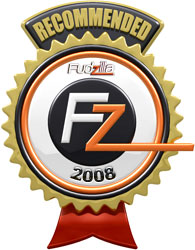

Review: Zotac delivers
After Nvidia gave a green light on selling overclocked 9800 GTX cards, we found a couple of versions of this card, one of which is our today’s card, Zotac Geforce 9800 GTX AMP Edition.
We’re familiar with AMP suffix because it always means some nice speeds, and Zotac once again delivered because 9800 GTX AMP’s core runs at no less than 756MHz. In case you don’t remember, reference speeds are 675MHz, which is 81MHz less. High overclock comes as no surprise because our previous testing revealed that 9800 GTX cards are great overclockers.
Already famous G92 chip is the heart of this card, and every card using this chip has made a name for itself. Just remember 8800 GTS /GT cards or 9800 GX2 cards that pack no less than two G92s. 9800 GTX’s G92 is built by TSMC in 65nm process and features 754 million transistors. The core didn’t undergo any major changes in this last iteration so all the characteristics that G92 offers are kept.

Geforce 9800 GTX is a card that should replace the famous but aging 8800 GTX that will soon be history. This new card packs some new features not found on the 8800 GTX cards, namely HybridPower technology, PCIExpress 2.0 and the new and improved Video processing engine. The new GTX is faster than 8800 GTX, but not significantly. If you own an 8800 GTX and don't care about these new features and overclocking potential, then we recommend you keep it. Still, 9800 GTX is a great card that will do a great job in satisfying your gaming and multimedia hunger. In scenarios where reference 9800 GTX can’t handle graphics, you can always turn to overclocking where you’ll most certainly get performance improvements. In fact, this is one of the most overclock-friendly cards on the market.

Zotac AMP running at 756MHz means that further overclocking shouldn’t be a problem, and that’s exactly what we did. We managed to push it up to 810MHz.
The card comes with 512MB of GDDR3 memory and it uses a 256-bit memory interface. AMP card’s memory is running at 2300MHz (reference speed is 2200MHz).
As far as looks are concerned, this card is no different from the rest of the 9800 GTX pack, be they reference or partner versions. Dual slot cooler covers the card and makes sure that it’s cooled and makes it look stylish at the same time. Working temperature hit about 74 °C.

HDMI+HDCP+Audio are supported through the HDMI adapter included in the box. In order to have HDMI with audio you must route your soundcard’s/motherboard’s SPDIF out to your graphics card using a cable also included in the box. Apart from two Dual Link DVI outs with maximum resolution of 2.560 x 1.600 we also have a 1x 7pin HDTV output.
Since the reference card consumes maximum 160W, the overclocked Zotac 9800 GTX will probably require a couple of Watts more. Just like the reference version, Zotac card features two 6-pin power connectors.

The packaging is a standard Zotac box with plenty of information and characters from the TV series “Lost.” That doesn’t mean that you can use 9800 GTX to view “Lost” in HD quality, but that the box contains the game “Lost.” We weren’t very impressed with the game, but it’s still worth it to give it a try. The graphics are nice, and 9800 GTX AMP will prove that it can churn out enough frames to provide pleasant gaming at all resolutions.

In the box you’ll find all the necessary equipment needed for gaming or HD content viewin.

Testbed:
Motherboard:
EVGA 680i SLI (Supplied by EVGA)
Processor:
Intel Core 2 Duo 6800 Extreme edition (Supplied by Intel)
Memory:
OCZ FlexXLC PC2 9200 5-5-5-18 (Supplied by OCZ)
during testing CL5-5-5-15-CR2T 1066MHz at 2.2V
PSU:
OCZ Silencer 750 Quad Black (Supplied by OCZ)
Hard disk:
Seagate Barracuda 7200.9 80GB SATA (Supplied by Seagate)
CPU-Cooler:
Freezer 7 Pro (Supplied by Artic Cooling)
Case Fans:
Artic Cooling - Artic Fan 12 PWM
Artic Cooling - Artic Fan 8 PWM
Benchmarking
We tested our Zotac 9800 GTX AMP Edition card running at 756MHz but we ended up using two more 9800 GTX cards in order to better paint the picture of how overclocking affects performance.

Futuremarks

In 3DMark06, Zotac 9800 GTX AMP card scored 12748 marks. The difference between this card and the reference one isn't that significant, but gaming usually puts things in perspective.
Gaming

In the first two games that we tested, Company of Heroes and Crysis, Zotac handled overclocking well and it clearly outperformed not only the reference card, but also MSI's 9800 GTX running at 720MHz but with memory speeds at reference 1100MHz.



Conclusion
Geforce 9800 GTX is one of the fastest cards ever built, and Zotac’s 9800 GTX AMP Edition card really goes a long way to show its overclocking potential and push the performance limit even further. This card is simply top-notch and will satisfy even the most demanding gamers. Thanks to overclocking, some results can be boosted by as much as 15% using Zotac’s 9800 GTX AMP.
Although the card features reference cooling, it’s quiet enough. With 512MB of GDDR3 memory and nice multimedia capabilities this card can take whatever you throw at it, and then some. You also get the game “Lost”, based on the popular TV series that some fans might like.
At first we were not sure if we should award this card, as it is faster than the reference one, but on the other hand you get at least ten percent faster than reference score, and this will cost you some €20 more. As we are talking about a really small amount of money we can recommend you go out and buy AMP! rather than the reference card.
If you want the best from Nvidia’s current offer, 9800 GTX AMP is definitely one of our favorites.

